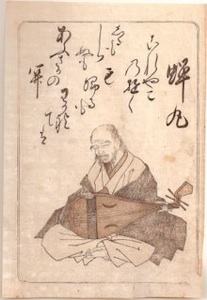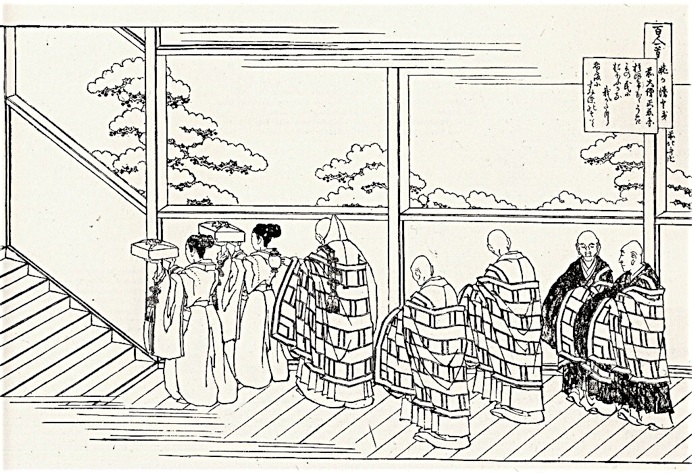前大僧正慈円


おほけなく
うき世の民に
おほふかな
わが立つ杣に
墨染の袖
さきのだいそうじょうじえん
おおけなく
うきよのたみに
おおうかな
わがたつそまに
すみぞめのそで
Abbot Jien
Unworthy though I am,
I hope to be the guardian to
The people in this wretched world,
From this here timbered stead,
Now dressed in black-sleeved robe.
Hokusai
Abbot Jien (1155 - 1225), or Saki no Daisojo Jien, was the son of Tadamichi (poem 76). He belonged to the Mikohidari poetry salon with Yoshitsune (poem 91) and Teika (poem 97) and was one of the Thirty-Six Immortal Poets. The Shugyoku Shu is a collection of his personal poetry. He also wrote the Gukan Sho (Notes on the Feelings of a Fool), a history of Japan (history for him is the story of decline, as set forth in Buddhist teachings), in which he hopes, for the sake of the country, for an honest shogun, whom he saw in Kujo no Yoritsune. There are 269 of his poems in imperial collections.
This poem refers to a much older poem in the Shin Kokinshu (20 - 1920) by Saicho, also called Dengyo Daishi, the founder of the Tendai sect of Buddhism on Mt Hiei:
(at the erection of the main temple on Mt Hiei, the Enryaku-ji)
阿耨多羅三藐三菩提のほとけたちわがたつそまに冥加あらせたまへ
Most omniscient
And supremely enlightened
Buddha Hosts!
On this timbered stead I enter,
Bestow your divine protection!
Mount Hiei was the place where Saicho built his temple and where Jien took office as the highest priest of the Tendai. Hiei means ‘woodcutters’ mountain’.
Tatsu means ‘to erect a building, to protect, occupy a position’, but also ‘to cut well, to stab (with a sword), to get in a fight’ (which could stand for Jien’s and Hiei monks’ determination to use the sword to protect their interests), and soma is both ‘timber’ and ‘woodcutter’, with tatsusoma clearly referring to Mt. Hiei and its temple. Sumizome is ‘dyed black’, referring to a Tendai priest’s robe with black sleeves. Peter Morse mentions in his Hokusai - One Hundred Poets that ookenaku means ‘undeservedly’ but also ‘being bold enough’, which last option would make Jien a rather arrogant potentate.
It looks like Hokusai did not warm toward the procession of clergy in his drawing. There is no feeling of protection radiating from the monks, who are shown cold and formal, shut inside their temple, aloof from the outside world, only the tops of the trees showing through, but even these blocked by the ‘timber’. Maybe Hokusai felt a dislike for these militant monks. The Hiei monks used the sword (in 1469 during the Onin wars they destroyed part of Kyoto) and also perished by the sword, and the temple was destroyed in 1571. The Enryaku-ji was rebuilt and until this day there are Tendai monks at Hiei.



